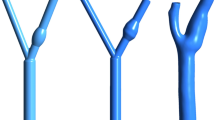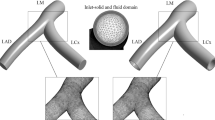Abstract
The effect of stenosis for a carotid artery bifurcation with elastic and rigid walls is investigated numerically. In the present study, the blood flow is considered as a laminar pulsatile flow. The effect of fluid-solid interaction is carried out using ANSYS-FLUENT software. The results show that the maximum wall shear stress in the stenosed artery is three times higher than that of a healthy artery. The shear stress gradient in elastic arteries Is lower than in rigid arteries. For rigid artery, the return flow and separation length in the diastolic phase is lower than the systolic phase.
Similar content being viewed by others
References
A. M. Shaaban and A. J. Duerinckx, Wall shear stress and early atherosclerosis: a review, American Journal of Roentgenology, 174(6) (2000) 1657–1665.
D. Young, Effect of a time-dependent stenosis on flow through a tube, Journal of Engineering for Industry, 90(2) (1968) 248–254.
J. S. Lee and Y. C. Fung, Flow in locally constricted tubes at low reynolds numbers, Journal of Applied Mechanics, 37 (1970) 9–16.
B. E. Morgan and D. F. Young, An integral method for the analysis of flow in arterial stenoses, Bulletin of Mathematical Biology, 36(1) (1974) 39–53.
T. Azuma and T. Fukushima, Flow patterns in stenotic blood vessel models, Biorheology, 13(6) (1976) 337–355.
G. Theodorou and D. Bellet, Laminar flows of a non-newtonian fluid in mild stenosis, Computer Methods in Applied Mechanics and Engineering, 54(1) (1986) 111–123.
S. I. Pinto, E. D. Costa, J. B. L. M. Campos and J. M. Miranda, Study of blood flow in a bifurcation with a stenosis, 15th International Conference on Experimental Mechanics (ICEM15) (2012) 1–5.
R. Manimaran, CFD simulation of non-Newtonian fluid flow in arterial stenoses with surface irregularities, World Academy of Science, Engineering and Technology, 73(5) (2011) 804–809.
H. I. Andersson, R. Halden and T. Glomsaker, Effects of surface irregularities on flow resistance in differently shaped arterial stenoses, Journal of Biomechanics, 33(10) (2000) 1257–1262.
I. Husain, C. Langdon and J. Schwark, Three-dimensional pulsatile non-Newtonian flow in a stenotic vessel, Computational Problems in Engineering, Springer International Publishing, Cham (2014) 55–64.
D. Jodko, D. Obidowski, P. Reorowicz and K. Jóźwik, Simulations of the blood flow in the arterio-venous fistula for haemodialysis, Acta of Bioengineering and Biomechanics, 16(1) (2014) 69–74.
C. X. C. Chen, Y. Ding and J. A. Gear, Blood flow in stenosed arteries using two-way, fluid-structural interaction, ANZIAM Journal, 51 (2009) C586–C611.
G. Liu, J. Wu, W. Huang, W. Wu, H. Zhang, K. K. Wong and D. N. Ghista, Numerical simulation of flow in curved coronary arteries with progressive amounts of stenosis using fluid-structure interaction modelling, Journal of Medical Imaging and Health Informatics, 4(4) (2014) 605–611.
M. Alishahi, M. M. Alishahi and H. Emdad, Numerical simulation of blood flow in a flexible stenosed abdominal real aorta, Scientia Iranica, 18(6) (2011) 1297–1305.
J. Dong, Development of a haemodynamic model for improving clinical treatment of vascular disease, Doctoral Dissertation, RMIT University (2015).
L. Kallekar, C. Viswanath and M. Anand, Effect of wall flexibility on the deformation during flow in a stenosed coronary artery, Fluids, 2(2) (2017) 16.
T. K. Khambhampati, A comparative study between Newtonian and non-Newtonian models in a stenosis of a carotid artery, Doctoral Dissertation, Texas A&M University (2013).
H. Gharahi, B. A. Zambrano, D. C. Zhu, J. K. DeMarco and S. Baek, Computational fluid dynamic simulation of human carotid artery bifurcation based on anatomy and volumetric blood flow rate measured with magnetic resonance imaging, International Journal of Advances in Engineering Sciences and Applied Mathematics, 8(1) (2016) 46–60.
M. Toloui, B. Firoozabadi and M. Saidi, A numerical study of the effects of blood rheology and vessel deformability on the hemodynamics of carotid bifurcation, Scientia Iranica, 19(1) (2012) 119–126.
A. S. Khader, S. B. Shenoy, R. B. Pai, N. S. Mahmood, G. Kamath and V. R. K Rao, A comparative fluid-structure interaction study of stenosed and normal common carotid artery, World Journal of Modelling and Simulation, 5(4) (2009) 272–277.
S. A. Khader, A. Ayachit, B. R. Pai, K. A. Ahmed, V. R. K. Rao and S. G. Kamath, FSI simulation of increased severity in patient specific common carotid artery stenosis, 3rd International Conference on Mechanical, Electronics and Mechatronics Engineering (2014).
S. A. Khader, A. Ayachit, R. Pai, K. A. Ahmed, V. R. K. Rao and S. G. Kamath, Haemodynamics study in subject specific carotid bifurcation using FSI, Int. J. Mech. Aerospace Ind. Mechatron Manuf. Eng., 8 (2014) 1885–1890.
J. Chen and X. Y. Lu, Numerical investigation of the non-Newtonian pulsatile blood flow in a bifurcation model with a non-planar branch, Journal of Biomechanics, 39(5) (2006) 818–832.
S. E. Lee, S. W. Lee, P. F. Fischer, H. S. Bassiouny and F. Loth, Direct numerical simulation of transitional flow in a stenosed carotid bifurcation, Journal of Biomechanics, 41(11) (2008) 2551–2561.
J. Wu, G. Liu, W. Huang, D. N Ghista and K. K. Wong, Transient blood flow in elastic coronary arteries with varying degrees of stenosis and dilatations: CFD modelling and parametric study, Computer Methods in Biomechanics and Biomedical Engineering, 18(16) (2015) 1835–1845.
A. Javadzadegan, A. Lotfi, A. Simmons and T. Barber, Haemodynamic analysis of femoral artery bifurcation models under different physiological flow waveforms, Computer Methods in Biomechanics and Biomedical Engineering, 19(11) (2016) 1143–1153.
A. S. Yong, A. Javadzadegan, W. F. Fearon, A. Moshfegh, J. K. Lau, S. Nicholls, M. K. Ng and L. Kritharides, The relationship between coronary artery distensibility and fractional flow reserve, PloS One, 12(7) (2017) e0181824.
J. Moradicheghamahi, J. Sadeghiseraji and M. Jahangiri, Numerical solution of the Pulsatile, non-Newtonian and turbulent blood flow in a patient specific elastic carotid artery, International Journal of Mechanical Sciences, 150 (2019) 393–403.
M. Kaewbumrung, S. Orankitjaroen, P. Boonkrong, B. Nuntadilok and B. Wiwatanapataphee, Numerical simulation of dispersed particle-blood flow in the stenosed coronary arteries, International Journal of Differential Equations, 2018 (2018).
A. Javadzadegan, A. Moshfegh, Y. Qian, M. K. Ng, L. Kritharides and A. S. Yong, The relationship between coronary lesion characteristics and pathologic shear in human coronary arteries, Clinical Biomechanics, 60 (2018) 177–184.
D. Ambrosi, A. Quarteroni and G. Rozza, Modeling of Physiological Flows, Springer Science and Business Media (2012).
C. A. Taylor and J. D. Humphrey, Open problems in computational vascular biomechanics: hemodynamics and arterial wall mechanics, Computer Methods in Applied Mechanics and Engineering, 198(45–46) (2009) 3514–3523.
R. Torii, M. Oshima, T. Kobayashi, K. Takagi and T. E. Tezduyar, Fluid-structure interaction modeling of a patient-specific cerebral aneurysm: influence of structural modeling, Computational Mechanics, 43(1) (2008) 151–159.
H. J. Kim, I. E. Vignon-Clementel, J. S. Coogan, C. A. Figueroa, K. E. Jansen and C. A. Taylor, Patient-specific modeling of blood flow and pressure in human coronary arteries, Annals of Biomedical Engineering, 38(10) (2010) 3195–3209.
R. Torii, N. B. Wood, N. Hadjiloizou, A. W. Dowsey, A. R. Wright, A. D. Hughes, J. Davies, D. P. Francis, J. Mayet, G. Z. Yang and S. A. M. Thom, Fluid-structure interaction analysis of a patient-specific right coronary artery with physiological velocity and pressure waveforms, Communications in Numerical Methods in Engineering, 25(5) (2009) 565–580.
Y. C. Fung, Biomechanics: Mechanical Properties of Living Tissues, 2nd Ed., Springer-Verlag, New York, USA (1993).
A. Valencia and F. Solis, Blood flow dynamics and arterial wall interaction in a saccular aneurysm model of the basilar artery, Computers and Structures, 84(21) (2006) 1326–1337.
C. Lally, A. J. Reid and P. J. Prendergast, Elastic behavior of porcine coronary artery tissue under uniaxial and equibiaxial tension, Annals of Biomedical Engineering, 32(10) (2004) 1355–1364.
S. Rahmani, T. Andriollo, M. R. Sonne and J. H. Hattel, A quantitative comparison of different constitutive formulations, Mechanics of Materials, 150 (2020) 103597.
M. Brust, C. Schaefer, R. Doerr, L. Pan, M. Garcia, P. E. Arratia and C. Wagner, Rheology of human blood plasma: Viscoelastic versus Newtonian behavior, Physical Review Letters, 110(7) (2013) 078305.
H. Hasegawa and H. Kanai, Measurement of elastic moduli of the arterial wall at multiple frequencies by remote actuation for assessment of viscoelasticity, Japanese Journal of Applied Physics, 43(5S) (2004) 3197.
Institue of Electronics, Lods University of Technology, http://eletel.eu/angiosim.
K. Perktold and G. Rappitsch, Computer simulation of local blood flow and vessel mechanics in a compliant carotid artery bifurcation model, Journal of Biomechanics, 28(7) (1995) 845–856.
A. Klepaczko, A. Materka, P. Szczypiński and M. Strzelecki, Numerical modeling of MR angiography for quantitative validation of image-driven assessment of carotid stenosis, IEEE Transactions on Nuclear Science, 62(3) (2015) 619–627.
S. W. Lee, L. Antiga and D. A. Steinman, Correlations among indicators of disturbed flow at the normal carotid bifurcation, J. Biomech. Eng., 131(6) (2009) 061013.
S. Z. Zhao, X. Y. Xu, A. D. Hughes, S. A. Thom, A. V. Stanton, B. Ariff and Q. Long, Blood flow and vessel mechanics in a physiologically realistic model of a human carotid arterial bifurcation, Journal of Biomechanics, 33(8) (2000) 975–984.
N. A. Buchmann and M. C. Jermy, Blood flow measurements in idealised and patient specific models of the human carotid artery, Proceedings of the 14th International Symposium on Applications of Laser Techniques to Fluid Mechanics, Lisboa, Portugal (2008) 7–10.
A. M. Malek, S. L. Alper and S. Izumo, Hemodynamic shear stress and its role in atherosclerosis, JAMA-Journal of the American Medical Association, 282(21) (1999) 2035–2042.
D. De Wilde, B. Trachet, G. De Meyer and P. Segers, The influence of anesthesia and fluid-structure interaction on simulated shear stress patterns in the carotid bifurcation of mice, Journal of Biomechanics, 49(13) (2016) 2741–2747.
C. K. Zarins, D. P. Giddens, B. K. Bharadvaj, V. S. Sottiurai, R. F. Mabon and S. Glagov, Carotid bifurcation atherosclerosis. Quantitative correlation of plaque localization with flow velocity profiles and wall shear stress, Circulation Research, 53(4) (1983) 502–514.
A. Sequeira and J. Janela, An overview of some mathematical models of blood rheology, Portrait of State-of-the-Art Research at the Technical University of Lisbon (2007) 65–87.
D. N. Ku, Blood flow in arteries, Annual Review of Fluid Mechanics, 29(1) (1997) 399–434.
X. Chen, J. Zhuang, H. Huang and Y. Wu, Fluid-structure interactions (FSI) based study of low-density lipoproteins (LDL) uptake in the left coronary artery, Scientific Reports, 11(1) (2021) 1–12.
Author information
Authors and Affiliations
Corresponding author
Additional information
Marzieh Rezazadeh received her M.S. in mechanical engineering from Ferdowsi University of Mashhad, Mashhad, Iran, in 2002 and her Ph.D. in mechanical engineering from Iran University of Science and Technology (IUST), Tehran, Iran, in 2013. Since 2014, she has been Assistant Professor of mechanical engineering at Isfahan University of Technology (IUT), Isfahan, Iran. Her current studies include fluid-solid interaction, numerical simulation of fluid mechanics, nanofluid flow simulation, biofluid flow simulation and Lattice Boltzmann method.
Ramin Ostadi received his M.S. in mechanical engineering from Isfahan University of Technology (IUT), Isfahan, Iran. His research interests are computational fluid dynamics.
Rights and permissions
About this article
Cite this article
Rezazadeh, M., Ostadi, R. Numerical simulation of the wall shear stress distribution in a carotid artery bifurcation. J Mech Sci Technol 36, 5035–5046 (2022). https://doi.org/10.1007/s12206-022-0917-9
Received:
Revised:
Accepted:
Published:
Issue Date:
DOI: https://doi.org/10.1007/s12206-022-0917-9




